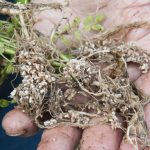The importance of Zinc
The importance of zinc for production of crops is well known. Zinc is a micronutrient that is essential for plant growth and avoiding deficiencies is vital for successful cropping.
In-furrow application of zinc in liquid form is a more recently accepted practice that has produced great results for hundreds of Liquid Systems (SA) customers, improving crop health and resilience and boosting yields.
The following enlightening article by Dr Bob Holloway, former OIC at Minnipa Research Centre (SARDI) delves into the history of research into zinc and liquid zinc application in Australia.
What is zinc needed for? – advantages of zinc
Zinc is micronutrient essential for all plants to grow and survive. The genes that allow plants to tolerate stress, such as during drought or under attack from disease, require zinc to function. Zinc is vital in allowing plants to absorb water. Plant cells need zinc to metabolise carbohydrates, proteins and growth hormones. Zinc is essential for pollen formation and for the stability of cell membranes.
Stable cell membranes allow nutrient ions to pass through them but act as a barrier to disease pathogens and also prevent leakage of water, sugars and amino acids that otherwise attract pathogens. Over several decades now, researchers have noted the connection between the severity of root disease in cereals and the amount of zinc available in the soil. The severity of boron toxicity is reduced in the presence of adequate zinc. Zinc is also an essential nutrient for humans and livestock and it has been proposed that the zinc content of grain could become an important part of grain quality assessment for market in the future. There are also large benefits of having high zinc concentrations in grain for seed, especially in areas where soil zinc concentrations are low.
Areas of Zn deficiency
Australia’s ancient, eroded soils are of low natural fertility and deficiencies of most micro nutrients have been recorded in crops. Zinc deficiency is the most widespread of these and has been recorded on both acid and alkaline soils.
Many Australian alkaline soils contain high concentrations of free lime (calcium carbonate) which originated on the sea floor and was blown inland. These alkaline soils have a chemical affinity to lock up micronutrients and are naturally low in available iron, zinc, manganese and copper. Alkaline black cracking clay soils are also susceptible to zinc deficiency. Zinc is increasingly less available to plants as alkalinity increases. Hence the heavy use of lime to reduce the acidity of some soils can reduce the availability of zinc to plants.
Until the need for zinc and other micronutrients was identified in Australia between the 1920’s and 1940’s, huge areas, in SA and WA particularly, were incapable of producing crops and pastures. The 90 mile desert in the south east of SA was an acid soil region with a white, sandy topsoil (Laffer sand), devoid of micronutrients, at least in forms available to plants. Adding zinc, manganese and copper along with superphosphate to these soils produced a miraculous transformation.
The native plants in these areas were able to grow happily in this low zinc environment and similarly there are variations in the ability of crop plants to tolerate low zinc soils. Durum wheat is generally highly susceptible to zinc deficiency. The bread wheat variety Excalibur proved to be reasonably tolerant to zinc deficiency and Indian mustard is also very tolerant to low zinc soils.
Until the 1980’s, visible signs of zinc deficiency in crops were not common because the superphosphate that was universally applied to crops and pastures had a zinc impurity of 0.04%, sufficient to supply and maintain most zinc requirements. When the market then changed to high analysis fertilisers MAP and DAP, free of zinc, zinc deficiency began to appear more frequently. By the early 1990’s, application of zinc solutions to crops or to the soil surface were increasingly common. Zinc was also added commercially to MAP and DAP (as zinc sulphate or zinc oxide) as a means of supplying zinc at sowing. It is important that zinc deficiency can severely reduce crop production before symptoms appear – early tissue tests are the best indicator of the zinc status of plants.
Liquid zinc –pros and cons
As the topsoil dries, roots move downwards to take up water but are often entering hostile territory where high pH, toxic concentrations of boron and salt and infertility can have a dramatic effect on their ability to support plant production. Cereal plants are able to take up zinc from the topsoil and transport it around the root system in ideal conditions but this function is reduced if there is less than adequate zinc in the topsoil. During drought, critical root functions are likely to suffer if the topsoil is dry and plants are relying on infertile subsoil for their nutrient supplies.
Most Australian subsoils are highly infertile and nutrients like zinc and phosphorus are concentrated in the top 100 mm where fertilisers are applied and mostly remain – except in the case of soluble nutrients like nitrogen which can move downwards with drainage. In the 1990’s field and pot trials were conducted at Minnipa on Eyre Peninsula in SA to study subsoil infertility, with liquid fertiliser containing nitrogen, phosphorus and zinc. Zinc uptake in grain and shoots of cereals was greatly improved by application of the nutrients in liquid form right down the root zone compared with application to the topsoil alone.
These improvements in zinc application efficiency (in a multi nutrient solution) led to further experiments with liquids on calcareous soils on Eyre Peninsula. The general result was that the availability of phosphorus was greatly increased by applying it in liquid form with nitrogen and zinc. The uptake of all three nutrients was improved and in drier areas, improved even more by placement of 30-50% of the solution with the seed and the remainder in the subsoil at a depth of about 150 mm below the seed or more. The use of liquid fertilisers greatly simplifies the ability of farmers to apply combinations of nutrients together in response to soil and plant tissue tests.
As a single example from many experiments, an acidified nitrogen-phosphorus solution with zinc applied to calcareous red soil produced 36% more grain than equivalent granular fertiliser. Zinc concentration in the grain was 20 mg Zn/kg compared with 14.4 mg Zn/kg with the granular fertiliser – a 39% increase. When zinc was applied as a liquid acidifed solution separately to the liquid nitrogen–phosphorus solution, the grain zinc concentration was 16.8 mg Zn/kg. Most of the results like this from a 10 year research program with liquid fertilisers are summarised in “Fluid Fertilisers-A South Australian Manual 2008” available from Arris.
The earliest mobile field plot experiments to study subsoil infertility in the field were conducted in the 1980s by Prof Robin Graham and Dr Julie Ascher and involved getting granular fertilisers down to 40 cm using an air seeder delivery system with a high power requirement. We were often perplexed as to how the principles could be transferred economically to field equipment. However, the design of liquid fertiliser injection systems in the past 15 years has rapidly advanced to the point where split zone applications of multi-nutrient liquids are now very efficient and practical. This has opened up a new era for accurate placement of multi nutrient solutions in zones where the roots are most able to access them.






